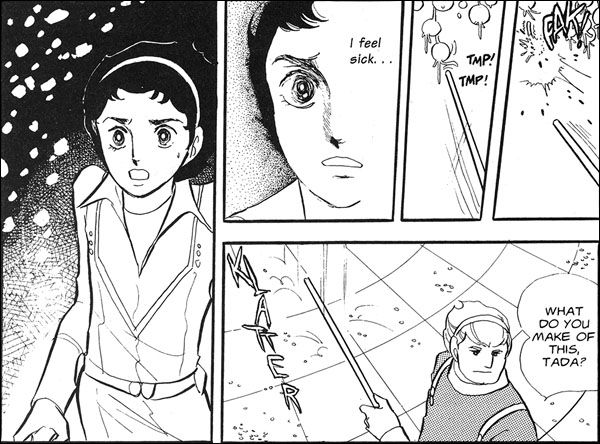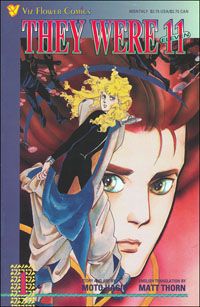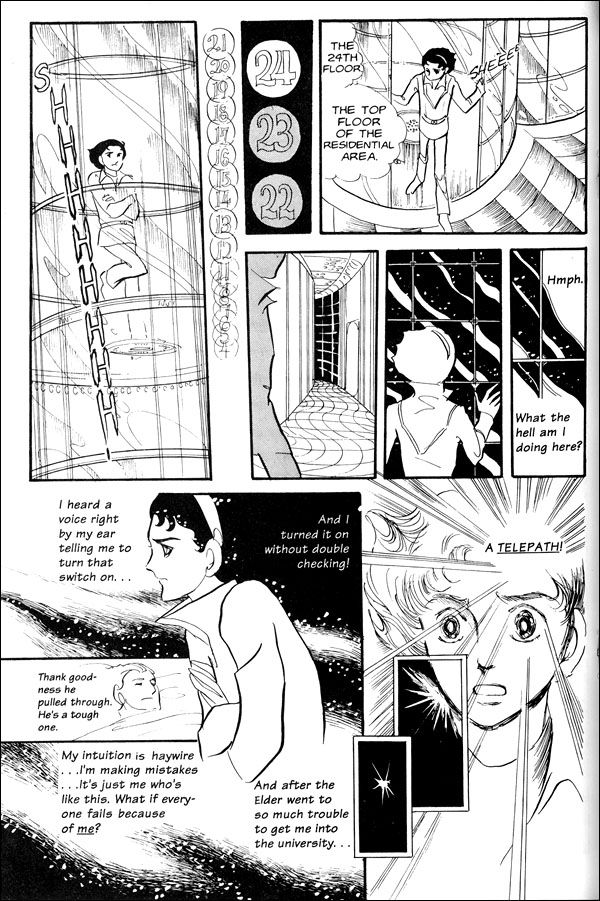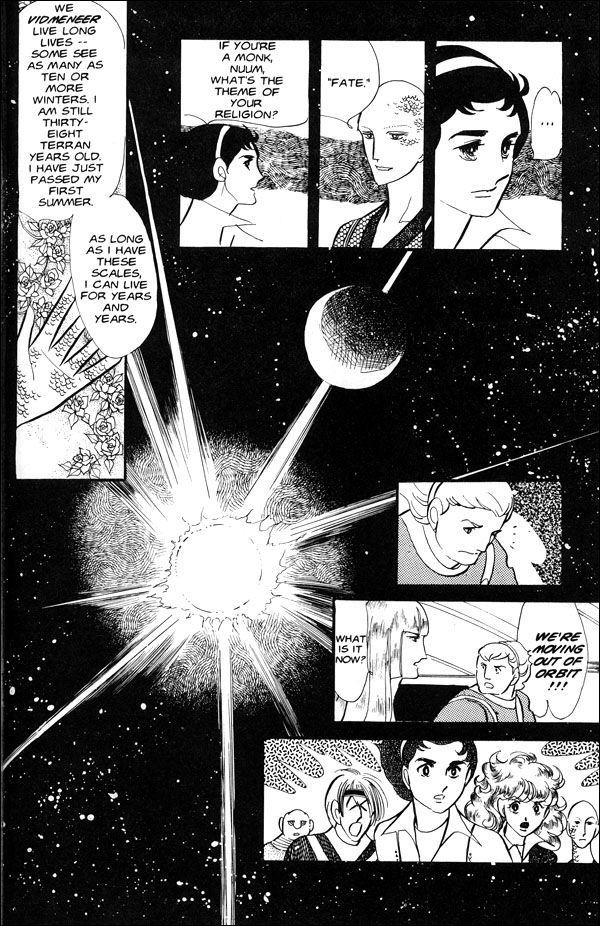They Were Eleven
by Moto Hagio
Published by Viz Media
| Sometime in the distant future, hopeful students from all over the galaxy gather for the difficult entrance exams at the elite Galactic University. For the final test, they are divided into computer-generated groups of ten students each and sent off to various locations where they must survive as a group for fifty-three days without pushing the provided emergency button, which immediately summons a rescue team, resulting in automatic failure of the entire group. One group is deposited on a derelict ship, devoid of engine power and filled with dangerous explosives, which they must safely maintain in orbit for the length of the test. As the group arrives on the ship, however, it becomes apparent that there are eleven students rather than the assigned ten, indicating that one of them must be an impostor. Potential disasters pile up quickly, including an unstable orbit and the presence of a deadly disease, and in the midst of it all the group begins to suspect Tada, a young Terran (Earth descendent) with intuitive powers and uncanny knowledge of the ship's layout, of being the eleventh member. |
|
With the ship's mechanical problems and deadly health threat driving things forward, it is young Tada's story that takes focus, as he struggles to understand his relationship with the decrepit ship while also attempting to clear himself of the other students' rapidly-mounting suspicion. Despite the fact that his intuition saves the group early on, it also becomes the greatest point of contention amongst the group, and as more about Tada's own history comes to light, each revelation seems to point more clearly to his potential guilt.
They Were Eleven ran over three issues in the Japanese magazine Shojo Comic in 1975. It was written and drawn by pioneering mangaka Moto Hagio, one of the famous "Year 24 Group" of female manga artists who revolutionized shojo manga, which up to that point had been mainly written by men. In the U.S. it was released in four "flipped" pamphlet-style issues from Viz Media in 1995, as well as in the compilation, Four Shojo Stories, both of which are now out of print (though the pamphlets are easily found on ebay). Lovingly adapted by Matt Thorn, They Were Eleven is an intriguing science fiction comic, featuring several of Hagio's most prevalent themes, including childhood trauma and gender identification.
Two of the characters in the story are species whose gender is not determined until adulthood. One of these, Frol, who is decidedly feminine in appearance (referred to hereafter as "her" and "she"), is taking the test because she will be allowed to become male if she passes, a privilege otherwise only granted to a family's oldest child. On Frol's planet, "men govern and women work," and becoming a woman would mean relinquishing all autonomy and joining the harem of the neighboring lord (eighteen years her senior), so it is understandable why she would want to instead take advantage of her society's male privilege and collect a harem of her own. Still, it's a little bit jarring that when the story finally reaches a point where it becomes clear that they may very well not pass the test, the only other alternative presented to Frol is for her to leave her own people, become a woman, and marry someone else. The fact that in every scenario her future as a woman leads directly to marriage is not a fantastic message for today's young girls (nor is the fact that Frol, the story's only obviously "feminine" character, is depicted as capricious and "simple") and it is this that dates the series more than anything else.
That said, in the midst of today's shojo offerings, it is refreshing to read a comic for girls in which a science fiction/mystery plot so markedly overshadows the story's minimal romance. The atmosphere of the story is extremely tense throughout, and the level of complexity packed into four short issues is seriously impressive.
One of the most interesting aspects of the story is the various backgrounds of the students on the voyage, and what brings each of them to Galactic University. One student is the newly-crowned king of his planet-nation, who is taking the exam only to test his own abilities with no intention whatsoever of entering the university. Another is a half-cyborg, whose body was created to test out a potential cure for his planet's deadly disease--one which kills every person on the planet by the age of thirty. Tada, whose parents both died when he was very young, seeks to make a way for himself out of the care of the Elder who adopted him. Each of the students has a rich backstory, some of which are only hinted at in this very short series, and each has his own personal determination to pass the final test. As the ship's trajectory pulls them further towards certain death, it is the prospect of failure that terrifies and energizes most of these students rather than the growing risk to their lives, pushing the stakes to a place much higher than mere survival.
What is difficult to appreciate now is just how revolutionary Hagio's art (and that of the others in the Year 24 Group) was at the time, as she eschewed the standard rectangle panel layouts of the day for innovative designs that were as vital to the tone and emotion of the story as the characters' dialogue and facial expressions. This kind of drawing is common today, not just in shojo manga, and it's difficult to imagine otherwise. Perhaps what is easier to note is that the art itself does not seem at all dated, and that alone is quite telling.
Something this manga brings to mind is the question of how much significance there is today in Japanese demographic categories, at least when importing manga to the west. In the case of We Were Eleven, for instance, it is difficult to determine just who wouldn't be interested in the story in terms of gender demographics. Its science fiction setting, mystery plot, and even the very small glimmer of romance seem very much in line with works enjoyed by girls, boys, women, and men alike, and even for western comics fans only the characters' oversized eyes are evidence of anything stereotypically Japanese. Reminiscent of the short stories of Ray Bradbury or Zenna Henderson, this comic uses the thrilling mysteries of space fantasy to provide food for thought about humanity and how we relate to and survive with each other.
For a glimpse into classic manga that is fast-paced, wrought with tension, emotionally compelling, and a pleasure to look at, Moto Hagio's They Were Eleven offers the perfect, bite-sized package.




